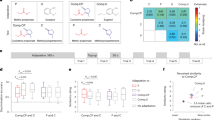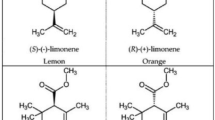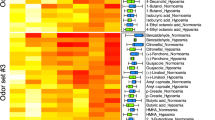Abstract
NOTHING is known of the mechanism by which small amounts of odorous material can trigger nervous impulses leading to smell sensations, because the characteristic odour of a substance has not hitherto been securely correlated with any other characteristic property of its molecules.
This is a preview of subscription content, access via your institution
Access options
Subscribe to this journal
Receive 51 print issues and online access
$199.00 per year
only $3.90 per issue
Buy this article
- Purchase on SpringerLink
- Instant access to full article PDF
Prices may be subject to local taxes which are calculated during checkout
Similar content being viewed by others
References
Dyson, G. M., Perf. Essent. Oil Record, 19, 456 (1928); 28, 13 (1937); Chem. and Indust., 16, 647 (1938).
Author information
Authors and Affiliations
Rights and permissions
About this article
Cite this article
WRIGHT, R. Odour and Chemical Constitution. Nature 173, 831 (1954). https://doi.org/10.1038/173831a0
Issue date:
DOI: https://doi.org/10.1038/173831a0
This article is cited by
-
Molecular complexity determines the number of olfactory notes and the pleasantness of smells
Scientific Reports (2011)
-
Odor and molecular vibration: Response to nitrobenzene-d5 of honey bees (Apis mellifera L.) conditioned with nitrobenzene
Experientia (1975)
-
Involvement of amino and sulphydryl groups in olfactory transduction in silk moths
Nature (1974)
-
Chemosensory Mechanism in American Cockroach Olfaction and Gustation
Nature (1973)
-
The response of the honeybee antennal CO2-receptors to N2O and Xe
Journal of Comparative Physiology (1973)



